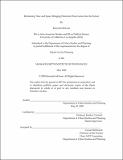Reclaiming time and space : bringing historical preservation into the future
Author(s)
McLean, Kenyatta.
Download1193560411-MIT.pdf (13.67Mb)
Alternative title
Bringing historical preservation into the future
Other Contributors
Massachusetts Institute of Technology. Department of Urban Studies and Planning.
Advisor
Karilyn Crockett.
Terms of use
Metadata
Show full item recordAbstract
Historic preservation has disproportionately focused on buildings and sites that support the social construction of the white American citizen identity. This is why only 8% of the United States National Register of Historic Places and 3% of the United States National Landmarks represent people of color, women or members of the LGBT community. The discriminatory exclusivity of historic preservation projects is fueled by criteria steeped in colonial values, only recognizing relationships to space and concepts of progress traditionally held by white people. Diversity in historic preservation projects requires methods that are grounded in the values and work of practitioners outside of traditional preservationist networks. Ground-up and side-in approaches to preservation make visible new values for use in identifying and supporting projects that will bring historic preservation into a more inclusive present and future. This project begins with the history of historic preservation exploring how the elitist values of its original practitioners normalized the viewing of history through the white gaze. Within the second section, I explain some Black communities' relationships to space and how historic preservation criteria render them as outside the "criteria of preservation." In the third section, I discuss how concepts of progress held by many Black communities are often nonteleological resulting in them being underserved by traditional preservation tied to linear experiences of time. The last section demonstrates what diversity can look like when projects are identified through a new lens influenced by more inclusive values and identities. This was done with the analysis of four restorative project case studies using the manifesto of BlackSpace. Historic preservation can be antiracist and restorative to Black people if it is willing to expand its identity and change its values.
Description
Thesis: M.C.P., Massachusetts Institute of Technology, Department of Urban Studies and Planning, May, 2020 Cataloged from the official PDF of thesis. Includes bibliographical references (pages 46-48).
Date issued
2020Department
Massachusetts Institute of Technology. Department of Urban Studies and PlanningPublisher
Massachusetts Institute of Technology
Keywords
Urban Studies and Planning.